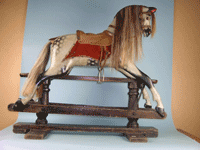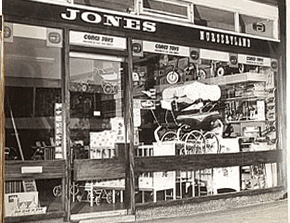

 |
 |
The Lines Bros, the three founders |
Walter Lines |
William Lines |
Athur Lines |
Lines Bros. Makers of Tri-ang ToysThe Lines family first became involved in the production of toys and baby equipment in about 1850. Their first factory was based at Bagnidge Wells, an early 'spa' near Kings Cross in London and their products were mainly produced in wood. The most popular products were wooden horses in a range of sizes. Tailors and saddlers of London's West End would purchase life-sizes wooden horses from this company to model their goods on. The Lines' factory later occupied an old steam works on the nearby Caledonian Road. G. & J. Lines was founded by brothers George and Joseph Lines in 1876. George Lines later retired leaving Joseph as sole proprietor. With 150 employees and still based on Caledonian Road, they were the largest toy factory in Great Britain at the time.
Caledonian Road Steam Works 1876 |
 |
 |
 |
They extended the factory and took over North Road Cattle Market and Carlo Gatti Ice Merchants next door to the Caledonian works. Later they also took over the old stable yard and the building of the London General Omnibus.They also had a subsidiary factory in Hackney Road known as Allen & Company, which was one of the oldest established makers of children's vehicles. On the 25 February 1887 G. & J. Lines applied for a patent for a toy horse invention. This year was also Queen Victoria's Golden Jubilee so the new horse became known as the 'Jubilee Hobby Horse'. Many of G. & J. Lines' rocking horses were supplied to the central London department store, Gamage's, based in Holborn. |
 |
 |
 |
G. & J. Lines introduced the Thistle trademark in 1910.
1910 Gypsy Caravan with typical thistle empblem In 1913 G. & J. Lines moved to a new location called Thistle Works in Down Lane, Tottenham in North London. They purchased four and a half acres of land complete with private railway sidings and built a new factory. G. & J. Lines continued to trade, until the death of Joseph Lines in 1931. In 1919, Joseph Lines' three sons William, Arthur and Walter, who had worked in their fathers' company since leaving school, returned from the First World War.
|
Early Factories.
Tottenham, Down Lane Thislte Works 1914 Ormside Street London 1919 Old Kent Road London 1921
Tri-ang Works, Morden Road, Merton S.W. 19. |
 |
 |
|
They were eager to set up a new company and in the same year Lines Brothers Limited was born. Directors on the board included Mr R. C. Munro, the owner of R. W. Munro Ltd., a well-known company in the engineering world and Sir Ralph Freeman, a civil engineer.
The first toys made by Lines Brothers were designed by Walter Lines. In 1921 Lines Brothers brought premises on Ormside Street on the Old Kent Road in South London. They soon gained customers such as Harvey Greenacre & Co. Ltd.of Durban, South Africa and the London department store, Harrods. By 1924 Lines Brothers were doing so well they had to relocate their 533 staff to a new, more high tech factory in Merton, South London. |
 |
They registered Tri-ang Toys as their brand name - a triangle is made up of three lines (three Lines brothers) - and the factory was named Tri-ang Works.
1931 was a busy year for Lines Brothers. They now had over 1,000 staff. They bought the famous London toy store, Hamleys, which had been struggling after a huge overspend on the development of the Regent Street premises.
They registered Pedigree as the name of their subsidiary doll-making company. Then they founded International Model Aircraft Ltd., a pioneer in the model aircraft business, later recognized as the finest in the world, which produced the first ever range of flying model aircraft - FROG (flies right off the ground). |
In 1933 Lines Brothers became a public company when 200,000 shares were issued. During the period between the First and Second World Wars, Lines Brothers acquired The Unique and Unity Cycle Co. This company was based in Birmingham and had been founded in 1888. They originally made bicycles for adults but the market for children's tricycles and bicycles grew so much that they later stopped production of full sized bikes.
|
During the Second World War Lines Brothers stopped making toys altogether and turned all their efforts to producing products necessary during the war. 7,000 people were employed to make over 1,000,000 machine guns, 14,000,000 magazines for Hurricane and Spitfire aircraft, as well as shell cases, land mine cases and special optical apparatus to help troops see in the dark. In 1940 the Merton factory was partially bombed.
On the 10 June 1941 King George VI visited the toy factory at Merton, to inspect the munitions production as part of the war effort and on the 28 May 1943 the Duchess of Kent also visited Merton.
|
TOYS COME BACK TO ENGLAND
October 29 1946 Tri-ang released this picture with this text: TOYS COME BACK TO ENGLAND -- Finished toys, ready for the Christmas markets of England and the rest of the world, line the display shelves in the Lines Bros. factory in London. The factory is turning out toys by the millions with use of mass production methods. Dolls, forts, trains, boats, motor cars and scores of other items are made in this manner. |
In 1945 Lines Brothers set up a factory at Merthyr Tydfil in Wales. On the 16 October 1946 Countess Granvill officially opened a new Lines Brothers factory in Belfast, Northern Ireland. This factory went on to produce the bulk of soft toys for Lines Brothers.
In 1946 Lines Brothers purchased a company called Joy Toys Ltd. which was based in New Zealand. Subsidiary companies overseas helped to solve the problem of increasing tariffs on exportation and to keep prices down. Lines Brothers installed the latest machinery to produce toys from wood, steel and plastic.
|
April 10 th 1947 Tri-ang wrote a letter to all worldwide dealers. (Letter)
In 1947 Lines Brothers founded a company in Canada. The trade mark used in Canada was the thistle which had first been used their father Joseph Lines so many years before.
In 1951 Lines Brothers purchased fifty percent of the Australian toy company Cyclops which became Cyclops & Lines Brothers (Australia) Ltd.
|
The MINIC range of toys cars and vehicles was introduced in 1935 having been registered in January of that year. The first range of model cars, 'Series 1', were released this year and were made up of 14 models. They filled a gap in the market between expensive large scale models and the die-cast Dinky Toys. The range later included Push and Go which were introduced in the 1950s, Minic Motorways which were introduced 1963 and Minic Ships which were introduced in 1959.
|
That year Lines Brothers also took over Rovex Plastics Ltd., which they devoted to production of electric railways. They were able to sell the new trains at such low prices that a whole new market opened up. Rovex Scale Models Ltd. moved to a new factory in Margate, Kent, where they produced the Tri-ang real scale model electric railway system.
In 1955 Lines Brothers purchased the remaining 50% of Cyclops & Lines Brothers (Australia) Ltd. In 1956 Lines Brothers took over an Australian company called Moldex Ltd. This company produced a range of plastic products and so were able to produce the Tri-ang scale model railways and Pedigree dolls.
In 1957 Lines Brothers took over the pram company Simpson Fawcett. In 1958 Tri-ang bought a company named Mini Models. This company used the trade mark Scalex and had introduced Scalextrics in 1952. Tri-ang improved the design and reduced its costs which was met with popular approval.
|
The Tri-ang empire created by Lines Brothers now claimed to be the largest toy manufacturer in the world. Pedigree launched Sindy in 1962. The teenage doll quickly became the new rival of the American doll, Barbie.
Lines Brothers brought Meccano Ltd. which included Dinky Toys from Hornby in 1964. To increase sales of the financially-struggling Meccano, Lines Brothers introduced other products which brought it up-to-date. They introduced Play-Doh, Cliki and Cliki-Plus, similar to Lego, in this first year
. In 1966 Tri-ang owned 41(!) companies word wide. Tri-ang and Hornby Dublo Railways were consolidated during this year and sold off the following year to Rovex Scale Models who continued the joint name Tri-ang-Hornby Railways. Meccano took over the manufacturing of Jones' Junior Stitch toy sewing machines, which continued when Meccano was sold, but the sewing machine was renamed Starlet from January 1971.In 1970 Meccano became known as Meccano Tri-ang Limited.
|
In 1971, due to failing business overseas and uncertain demand in the UK, Lines Brothers, now the biggest toy manufacturer in the UK, collapsed.
Airfix bought Meccano, Dunbee Combex Marx bought Rovex Triang, Triang-Pedigree was bought by Barclay Securities, which included the Merton factory, the teddy bear range was taken over by Canterbury Bears and the Pedigree production manager Jim Mulholland set up his own factory in Belfast named Mulholland & Bailie. A while ago I made contact with an ex employee of the Triang Merthyr Tydfil factory who worked in the research and development section. He was there when the liquidators came in. He mentioned that Airfix were interested in buying the company and installed a computer which was new technology then. What Triang didn't realise straightaway was Airfix was downloading any information that they could use. He also said about the amount of what would now be highly collectable items which went into skip bins. During 1971, TUBE INVESTMENTS LTD of UK , having taken over many toy Companies and brands: Lines Bros UK, Lines Bros Montreal, Meccano, Hornby, Raleigh Cycles, Sturmey Archer, Pedigree Dolls, Cyclops Australia, Tri-ang Pedigree, as well as many others, cast an approving eye over their NZ cousins, and took them over with a purpose to 'wind them down', so they could 'wind them up'---which they did. No one in NZ was big enough to take Tri-ang-Pedigree NZ over.
The Meccano subsidiary of Tri-ang Toys gained sufficient financial backing to transfer its assets into a temporary holding known as Maofords Ltd., which was later renamed Meccano Ltd. and sold to Airfix. In 1978 Triang-Pedigree announced the closure of the company's Merthyr Tydfil factory in Wales, despite a rescue attempt in 1975 with a £4 million injection from government and Airfix.
In 1983 Sharna Tri-ang Ltd., based at Lumb Mill in Droylsden, Manchester, took over from Tri-ang Toys at Merthyr Tydfil. They went on to launch a new range of toys based on children's TV programs, such as Knight Rider, Street Hawk, Roland Rat, The A-Team, The Get A-Long Gang and Postman Pat.
|
Below ,pictures of Dealer "Jones of Coventry"(1950), who was a Tri-ang Agent |
 |
 |
Back to the homepage: CLICK HERE |